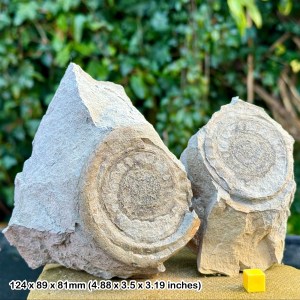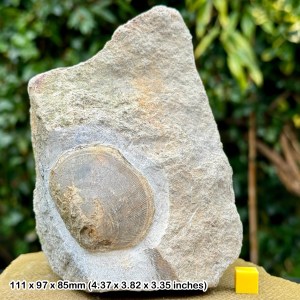On the opposite side of the River Severn from the famous Aust Cliff, there are the much less famous Sedbury Cliffs. At what first appears to be a location similar but far less productive than Aust, it is actually a very productive location for Jurassic fossils.
DIRECTIONS
♦ From Chepstow, take the road to Sedbury. You will drive past a school and the road will eventually veer to the right. You will pass a sharp bend, with a bus stop further along on your right. On the left, you will pass the footpath just before Loop Road.
♦ Do not park in Loop Road. Instead, continue along Beachley Road and you will find a lay-by outside Three Salmons House. Walk back towards the footpath above marked Offa’s Dyke’ which is also marked on OS 1:50,000 maps. Take this path and then immediately take the footpath marked to Sedbury Cliffs.
♦ From here, follow the path until you reach the grass area beside the cliffs and head northeast towards the cliffs. You will eventually come to the area being washed by the river, which is full of blocks of limestone.
♦ Ref: 51.63364°N, 2.64649°W
PROFILE INFO
FIND FREQUENCY: ♦♦♦♦ – Fossils at Sedbury are easily found, although you will often need a hammer to spilt the rocks. These are nearly always Lower Lias ammonites and brachiopods, but Triassic bones can also be found.
CHILDREN: ♦♦♦♦ – As long as children are supervised by adults and kept away from the mudflats, this location is suitable for children, although some may find it a little too far to walk.
ACCESS: ♦♦♦ – This location is easy to find, but there is about a 2.5km walk to get to the cliffs. Parking is in a lay-by, which is not that far from the public footpath.
TYPE: – The cliffs here are mostly obscured by trees, but it is the foreshore that produces the fossils. Regular cliff falls drop limestone blocks down onto the foreshore, producing fresh material to search for fossils.
FOSSIL HUNTING
When collecting at Aust, you can see the Sedbury cliffs across the water. They appear somewhat overgrown, which is a little misleading considering how productive they can be. When you reach the cliffs, you will notice the same formations as Aust – the famous red cliffs, with the Tea Green Marl and Lias at the top. The cliff face can only just be seen in between all the fallen trees. As you walk past the first part of the cliff, which is actually quite a long walk, you will see blocks on the foreshore in the distance. These blocks, and particularly past the first headland, is where you start finding fossils.
The blocks are Lower Lias, which (towards the middle and end of Sedbury Cliffs) become quite thick at the top of the cliff, in fact, far thicker than those at Aust. You may find a few ammonites and bivalves in this middle part of the cliff, but the most productive blocks fall from the cliffs past the first headland. Here, the blocks on the foreshore are full of ammonites and bivalves, and splitting them often leads to some decent finds.
There are different types of Lower Lias blocks, some with flatter ammonites, and others in an easy to split limestone. There are also superbly preserved calcite ammonites in a very hard blue limestone, similar to those found in the Birchi nodules at Charmouth. The ammonites can range from just a few millimetres in size to about 15cm inches or more. Crinoids can be found loose in the fine material along the foreshore.
You can also find blocks of the Triassic Westbury beds, like at Aust, but they are far less common. It is often the case that you won’t find any blocks of these lying around, but if you do, similar fossils (teeth and bones) can be found as in the beds at Aust.

GEOLOGY
Like Aust, most of the cliffs are Triassic, unfossiliferous Red Marls and Tea Green Marls. Above these are the Rhaetic Beds, which are thinner than at Aust. The difference is that the Jurassic Lower Lias at Sedbury makes up a larger proportion of the beds than the opposite side of the Severn and are much thicker. The Lias at Aust consists of thin beds, mostly of shale. Here, thick limestone beds yield ammonites and brachiopods.


SAFETY
Common sense when collecting at all locations should be used and knowledge of tide times is essential. The main dangers here are the mudflats and being cut off by the tide.
EQUIPMENT
You will need a good hammer, a chisel and eye protection at this location, and paper to wrap fossils.
ACCESS RIGHTS
This site is a site of special scientific interest (SSSI). This means you can visit the site, but hammering the bedrock is not permitted. For full information about the reasons for the status of the site and restrictions, download the PDF from Natural England..
It is important to follow our ‘Code of Conduct’ when collecting fossils or visiting any site. Please also read our ‘Terms and Conditions‘
LINKS
♦ Buy Fossils, Crystals, Tools
♦ Location Discussions
♦ Deposits Magazine
♦ Join Fossil Hunts
♦ UK Fossils Network


































